| Columns Retired Columns & Blogs |
Horn Shoppe Horn loudspeaker Measurements
Sidebar 3: Measurements
Despite its minuscule drive-unit, the Horn Shoppe's Horn is very sensitive, at an estimated 94dB(B)/2.83V/m. Its impedance also stays above 8 ohms over the entire audioband (fig.1), meaning it is both sensitive and efficient. But the raggedness of the traces in this graph is a little alarming, as are the peaks at various frequencies, implying the presence of resonances.
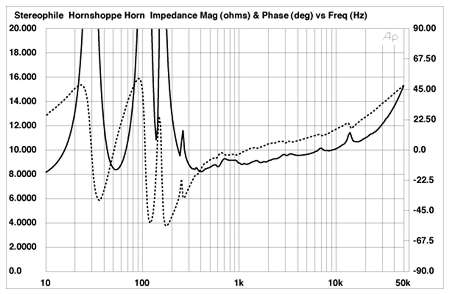
Fig.1 Horn Shoppe Horn, electrical impedance (solid) and phase (dashed). (2 ohms/vertical div.)
Examining the cabinet's vibrational behavior with a simple accelerometer revealed a fairly strong mode at 254Hz on all surfaces (fig.2), as well as others at 610Hz (this was very strong on the sidewall) and just above 100Hz (the drive-unit's low-frequency tuning frequency). However, the Horn's high sensitivity will mean that these resonances will not be as audible as might be expected: for a given SPL, the drive signal to the speaker will be considerably lower than with a conventional speaker, reducing the influence of the cabinet behavior.
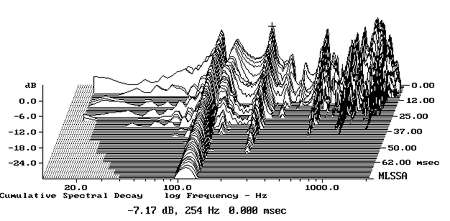
Fig.2 Horn Shoppe Horn, cumulative spectral-decay plot calculated from the output of an accelerometer fastened to the center of the front baffle. (MLS driving voltage to speaker, 7.55V; measurement bandwidth, 2kHz.)
The saddle at 52Hz in the impedance magnitude plot implies that the rear opening of the horn acts to some extent as a conventional reflex port, this confirmed by the driver's nearfield response (fig.3, black trace), which has a minimum-motion notch at the same frequency. But note that the horn opening has a series of resonant peaks in the midrange (fig.3, red trace), which coincide both with the peaks in the impedance plot and with suckouts in the drive-unit's nearfield response. I haven't attempted to calculate the summed output of these responses—it will depend on the effect of the room to a much larger extent than with a box speaker. It's possible that it all evens out, to give an evenly balanced midband. Or it might not. Like AD, I found that some bass instruments sounded "plummy"—a bit too resonant.
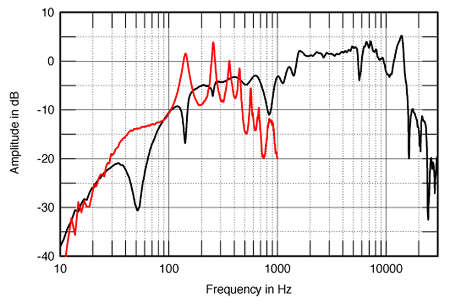
Fig.3 Horn Shoppe Horn, anechoic response on driver axis at 50", averaged across 30 degrees horizontal window and corrected for microphone response, with nearfield responses of the woofer (black) and horn opening (red), plotted below 300Hz and 1kHz, respectively.
Higher in frequency in fig.3, the entire treble region is plateau'd up by 3-5dB compared with the midrange level. This will make the speaker sound detailed and lively, and, I am sure, contributed to Art's finding the speaker to pass the "oblique listening test." However, the danger is that this balance will become fatiguingly bright over time. As AD didn't notice this, I must assume that this will be amplifier-dependent. Use the Horn with a solid-state power amp with a low source impedance and you'll run from the room. But use it with a single-ended triode and the treble balance will adjust itself accordingly. Note that, even without a tweeter, the Horn has good output up to 15kHz or so, though I note that AD was bothered by its lack of HF extension.
With its tiny drive-unit, the Horn has excellent lateral dispersion up to about 4kHz, when cone breakup starts to make it look a little ragged off-axis (fig.4). What surprised me about this graph was that the speaker's dispersion in the top octave was quite respectable. Again, this will contribute to the speaker's sounding lifelike from outside the listening room. The Horn's vertical dispersion (not shown) was also excellent, making the speaker unfussy regarding exact listening axis—much less so than the Meadowlark Swift, for example.
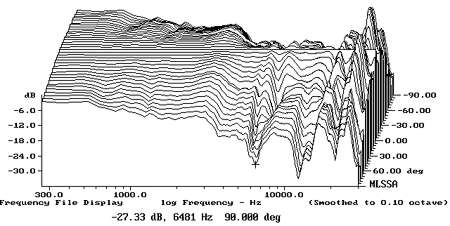
Fig.4 Horn Shoppe Horn, lateral response family at 50", normalized to response on driver axis, from back to front: differences in response 90 degrees-5 degrees off-axis, reference response, differences in response 5 degrees-90 degrees off-axis.
The Horn's step response (fig.5) was time-coherent, though broken up by some ringing. Tying in with this behavior, the speaker's cumulative spectral-decay plot (fig.6) has two strong ridges of delayed energy in the mid-treble, as well as another in the upper midrange (this associated with a suckout in the on-axis response) and one in the top octave.
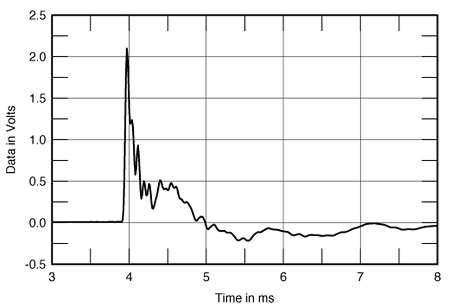
Fig.5 Horn Shoppe Horn, step response on driver axis at 50" (5ms time window, 30kHz bandwidth).
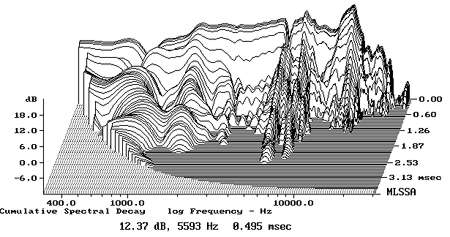
Fig.6 Horn Shoppe Horn, cumulative spectral-decay plot at 50" (0.15ms risetime).
The Horn Shoppe Horn's measured behavior looked alarming, but AD's auditioning indicates that, under the right circumstances, what it does wrong can be outweighed by what it does right.—John Atkinson
- Log in or register to post comments




































